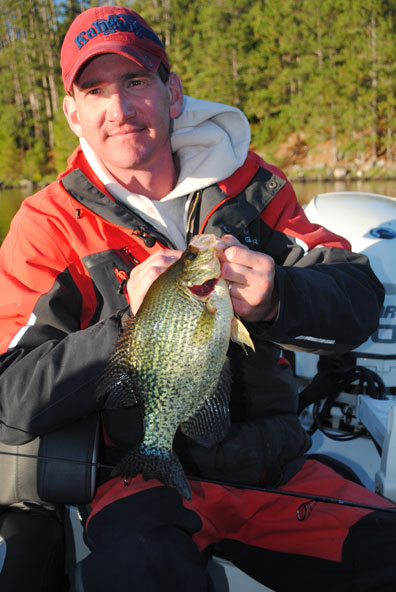CRAPPIES IN
DEEP WATER
by
Bob Jensen
Wherever
people fish anywhere in North America, there are a good number of
anglers that look forward to the fall months. At this time of
year, if a fish sees your bait, there’s a very good possibility that it
will eat that bait. Right now, fish are willing
biters. They can sense a change in water temps and length of
day and they know that things are going to change. From now
until it’s too cold to be on the water, fishing can be really, really
productive.
 In
different areas, some fish species get more attention than
others. Across the Midwest, walleyes are very
popular. In the south and mid-south, bass are boss.
But almost wherever you live, crappies appeal to lots of anglers, and
they seem to be getting more popular. Crappies, in most
places, are abundant and they're great on the table.
Depending on the body of water, here's how you can catch crappies right
now.
In
different areas, some fish species get more attention than
others. Across the Midwest, walleyes are very
popular. In the south and mid-south, bass are boss.
But almost wherever you live, crappies appeal to lots of anglers, and
they seem to be getting more popular. Crappies, in most
places, are abundant and they're great on the table.
Depending on the body of water, here's how you can catch crappies right
now.
In
some lakes crappies will gather in the basin of the lake and behave
much like a walleye would. In fact, on a sonar, it’s easy to
mistake crappies for walleyes. They'll hug the bottom in
large schools. They might be near a point or some other
underwater structure, but they might also be far from any
structure. It’s not unusual to find them in twenty to thirty
feet of water. The thing they're looking for is
food. It might be minnows, but it could also be bugs that
live in the mud on the bottom. The fastest way to find these
crappies is to cruise over the basin while watching your
sonar. Occasionally they’ll be suspended, but often they'll
be on the bottom. When you see them, hover directly overhead
and drop a jig/plastic or jig/minnow on them. You will almost
always get bit.
Another
place to find crappies is a short distance from the edge of the deep
weedline. They’ll suspend within casting distance of the deep
weedline looking for something to eat. The best way to find
them is to watch for small dimples on the surface of the
water. You need calm wind conditions for this pattern because
you can't see the dimples created as Mr. PaperMouth sucks a bug off the
surface when it's windy. Late afternoon and early evening are
when this pattern is most productive. Again, a jig with
plastic or a minnow is good, either slowly retrieved just a couple of
feet under the surface or fished under a slip-bobber.
One
last technique: Several times in the fall I’ve fished on
reservoirs or lakes where anglers are permitted to “plant”
brushpiles. They somehow connect logs and limbs and such and
sink these brushpiles near a dock. The best docks are those
close to deep water, twelve feet or deeper. It takes some
sonar work to find these brushpiles, but when you do find them, they
can provide outstanding crappie action. You can cast to them
with a jig and retrieve it, but what really works well is to employ a
jig below a slip-bobber. Set the bobber so your jig is just
above the brushpile. By using a slip-bobber, you can let the
jig sit in place, or you can slowly reel it back in. It often
works well to shake your rod tip to put a little action on the jig,
then let it sit still for a few seconds. If a crappie is down
there, you’ll know about it pretty quickly.
A
sixteenth ounce jig with a minnow is the traditional crappie
presentation, but more and more, plastic is taking the place of
minnows. Plastic baits come in a variety of colors and shapes
and doesn’t require care like minnows do. When swimming the
jig, go with a Mr. Crappie Grub or Slab Slanger. Under a
slip-bobber, a Mr. Crappie Crappie Thunder is hard to beat.
There’s
probably a lake, pond, or reservoir near where you live that is home to
crappies. Wherever you fish and however you fish, now is a
good time to get after them.
To
see recent and not-so-recent episodes of Fishing the Midwest
television, fishing articles, and fishing video tips and updates visit
fishingthemidwest.com